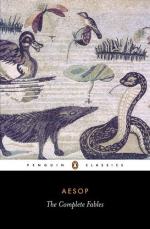|
This section contains 8,409 words (approx. 29 pages at 300 words per page) |

|
SOURCE: "Introduction," in Caxton's Aesop, pp. 3-21. Cambridge, Mass.: Harvard University Press, 1967.
In the following essay, Lenaghan traces the textual history of William Caxton's 1484 English translation of Aesop's fables, discusses the popularity of the fable format during the Middle Ages. Lenaghan suggests that Caxton's treatment of the fable anticipates aspects of Renaissance humanism.
Aesop's fables have been popular from papyrus to television. While our children read them in school, we read Marianne Moore's translations of La Fontaine or Thurber's fables in The New Yorker and thus repeat once more an old pattern, for Roman and medieval schoolboys did their primer fables while their parents read about the Horatian mice or Chauntecleer and Pertelote. The practice of attributing such fables to Aesop is centuries-old, but since for almost as many centuries there has been no firm knowledge about him, the identification has been more legendary than biographical.
Under the...
|
This section contains 8,409 words (approx. 29 pages at 300 words per page) |

|


